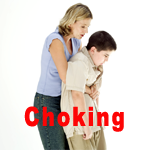Choking (Adult or Child)
It’s estimated that approximately 3,000 adults die each year from choking. In 1974 Dr. Henry Heimlich published an article in the Journal of Emergency Medicine, outlining an abdominal thrusting procedure called the ‘Heimlich Maneuver’. Since then, most organizations have endorsed this process for expelling any foreign substance that is completely blocking a victim’s airway.
The vast majority of choking cases involve food, especially when alcohol is involved. If a person begins to choke, encourage them to cough forcefully. In most cases a person will relieve the item on their own.
If they are unable to cough or the cough turns into a high pitched wheeze, confirm they are really choking by asking “are you choking.” If you receive a positive response, such as the victim shaking their head up and down, then send someone to call 911 and begin administrating abdominal thrusts (also known as the Heimlich Maneuver).
Relieve Choking for an Adult or Child
(Victim’s over the age of one and up)
Start by position yourself behind the victim. Place one leg in between the victim’s legs to create a stable base. This will help you control the victim’s descent if they become unconscious.
Next, find the victim’s bellybutton. You can do this easily by placing both of your hands on opposite sides of the victim’s ribs, just below the armpits. Now lower your hands, along the victim’s side, until you reach the top of the hip bone or pelvis. Move your hands towards the center of the victim’s abdomen. The bellybutton will line up with the top of the victim’s hips.
Quickly make a fist with one hand and place the thumb side of the fist against the victim’s stomach, just above their bellybutton. The knuckles of your fist should be pointing up and towards the sky. Clasp your fist with your other hand and begin forcefully thrusting your fist inward and upward, like forming the letter “J.” Continue these abdominal thrusts until the object is relieved or the victim becomes unconscious.
This thrusting action creates pressure on the diaphragm, which compresses the lungs, forcing air quickly out of the lungs to help dislodge the object stuck in the trachea or air-passage. In most cases, the item will be relieve after 2 or 3 abdominal thrusts, but continue these thrusts if the object hasn’t been removed.
All victim’s should be seen by a physician even if the object was dislodged. Though it is not common, internal injuries can occur. If the victim refuses to seek medical attention, monitor their condition for the next several hours. If any signs of shock begin to manifest, call 911 immediately.








